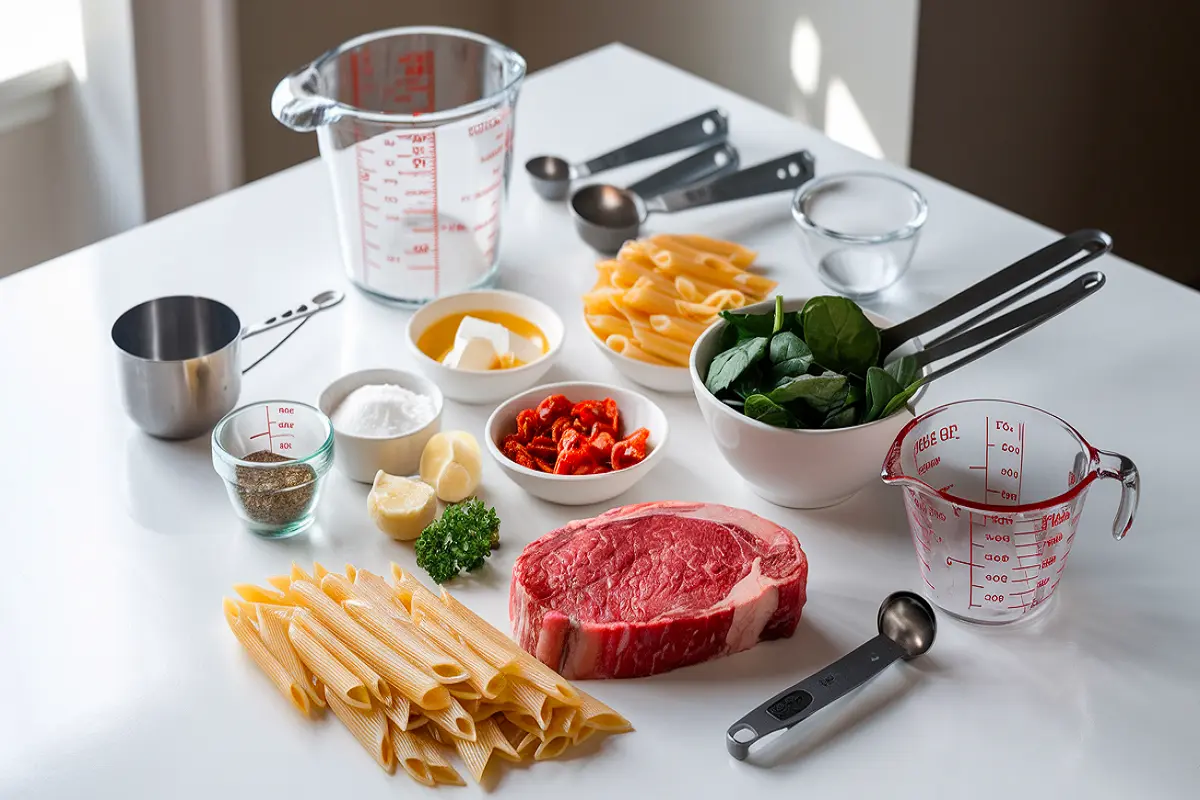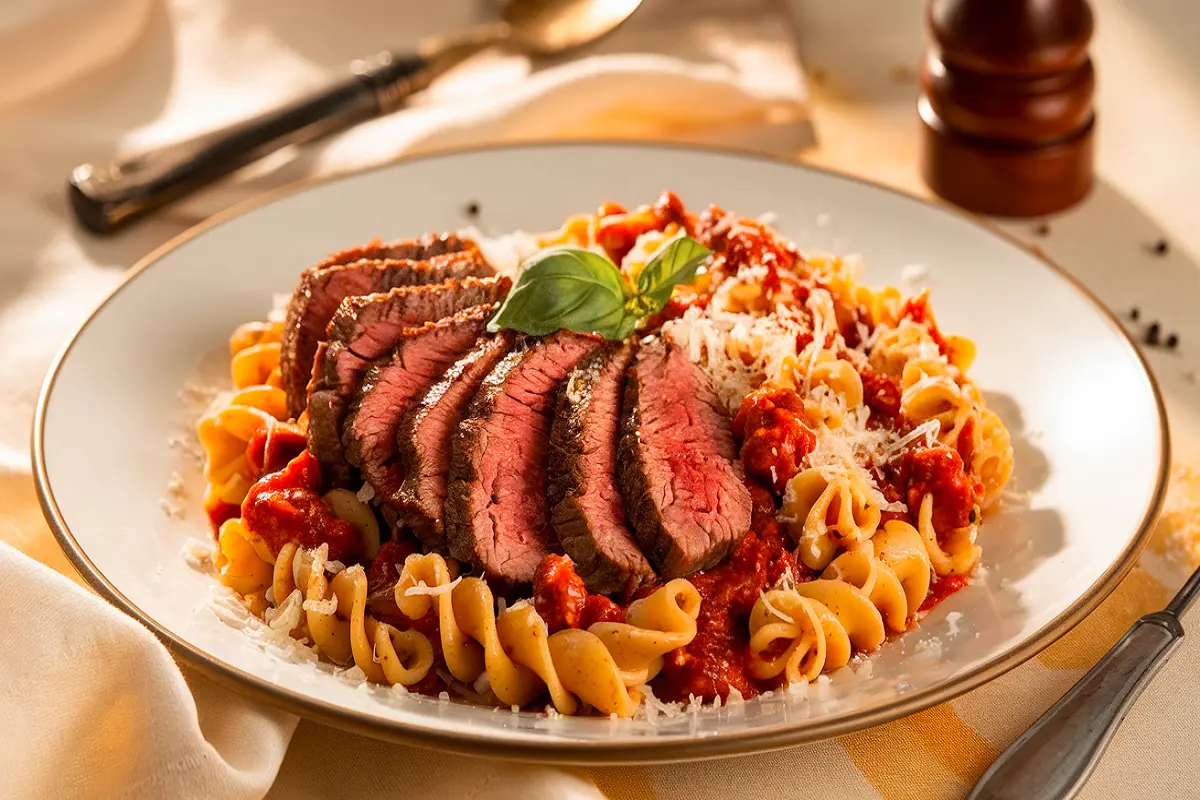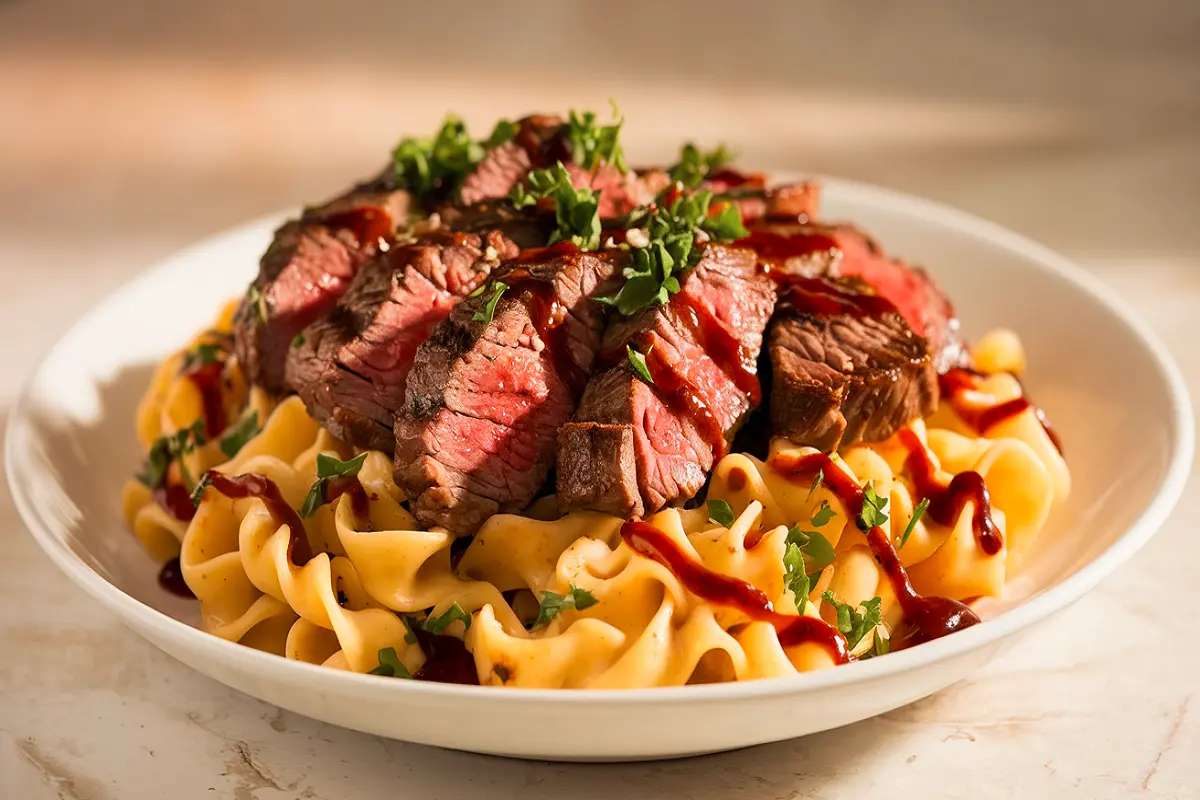A steak pasta recipe is the ultimate fusion of robust steak and creamy, rich pasta, creating a dish that feels both indulgent and comforting. Whether you’re planning a special dinner or need a satisfying weeknight meal, this recipe is versatile enough to impress on any occasion. The combination of tender steak and flavorful pasta sauce, enhanced with savory garlic, rich cheeses, and fresh vegetables, makes this a show-stopping dish that’s sure to become a family favorite. In this guide, we’ll break down everything you need to know about making this dish, from selecting the right steak to preparing a luscious sauce.
Introduction
The steak pasta recipe is a classic for good reason. Imagine juicy, perfectly cooked steak mingling with creamy, well-seasoned pasta. This dish is the epitome of comfort food. While traditionally thought of as a restaurant dish, it’s surprisingly easy to make at home with just a few key ingredients. By following this guide, you can create a luxurious meal that feels gourmet without requiring hours in the kitchen. Whether you’re a pasta lover, a steak enthusiast, or both, this dish will undoubtedly become a staple in your culinary repertoire.
Ingredients for Steak Pasta Recipe

Selecting the right ingredients is crucial for achieving the perfect balance of flavors in your steak pasta recipe. Here’s a detailed breakdown of the ingredients and their roles:
1. Steak
Steak is the highlight of this dish, providing a hearty and flavorful component. The choice of cut can dramatically affect the final texture and taste:
- Ribeye Steak: Known for its marbling, ribeye delivers an intensely rich flavor and a tender texture.
- Sirloin Steak: This leaner cut still has plenty of flavor and offers a more affordable option without sacrificing quality.
- Flank Steak: A tougher cut but, when sliced against the grain, it becomes tender and flavorful. This is an economical option that works beautifully in pasta dishes.
Substitutions: For a lighter protein, substitute chicken or shrimp. Tofu works as a vegetarian alternative, offering a firm texture that absorbs flavors well.
2. Pasta
Pasta forms the foundation of the dish, and its texture plays a key role in creating a satisfying mouthfeel. Choose a pasta that holds up to the rich sauce and steak:
Fettuccine or Pappardelle: These wide, flat noodles are ideal for creamy sauces as they cling well to the pasta, providing a rich bite.
Penne or Rigatoni: Tubular pastas are perfect for capturing small bits of steak and sauce inside their ridges, ensuring each bite is flavorful.
Substitutions: For a gluten-free option, use brown rice pasta or chickpea pasta. For a low-carb version, you can substitute with zucchini noodles or spaghetti squash.
3. Olive Oil
Olive oil is used to sear the steak and sauté the garlic. Its mild flavor adds richness without overpowering the other ingredients.
Substitutions: You can substitute with avocado oil, which has a high smoke point, or use butter for a richer, creamier flavor profile.
4. Garlic
Garlic is essential for building the flavor base of the dish. Sautéed garlic adds depth to the creamy sauce, balancing the richness of the cheese and cream with its slightly spicy, aromatic flavor.
Substitutions: Shallots or onions can also be used in place of garlic, though they will impart a slightly different, sweeter flavor.
5. Heavy Cream
Heavy cream adds a velvety richness to the sauce, making it smooth and indulgent. It coats the pasta beautifully and blends seamlessly with the steak juices.
Substitutions: For a lighter option, you can use half-and-half or whole milk, though the sauce may be thinner. Coconut cream can be used for a dairy-free option, but note that it will impart a slightly sweet, coconut flavor.
6. Parmesan Cheese
Freshly grated parmesan cheese adds a salty, nutty flavor to the sauce, enhancing the overall richness of the dish. It also helps thicken the sauce as it melts into the cream.
Substitutions: Pecorino Romano or Grana Padano can be used in place of parmesan for a similar flavor profile. For dairy-free options, use a vegan parmesan substitute made from nutritional yeast and cashews.
7. Fresh Vegetables
Incorporating fresh vegetables like spinach and sun-dried tomatoes not only adds color and texture to the dish but also introduces a fresh, slightly sweet element that complements the savory flavors of the steak and cheese.
- Spinach: Provides a mild, fresh flavor and wilts perfectly in the heat of the pasta.
- Sun-Dried Tomatoes: Adds a sweet, tangy flavor that cuts through the richness of the cream sauce.
Substitutions: You can substitute spinach with kale or arugula, while cherry tomatoes or roasted bell peppers can replace sun-dried tomatoes.
Step-by-Step Guide to Preparing Steak Pasta Recipe
1: Preparing the Steak
- Season the Steak: Generously season both sides of your steak with salt, pepper, and any additional herbs or spices you prefer, such as thyme or rosemary.
- Heat the Oil: Add olive oil to a skillet over medium-high heat. Once the oil is hot, sear the steak for 3-4 minutes per side until a golden-brown crust forms.
- Check Doneness: Depending on your preference for steak doneness, use a meat thermometer. For medium-rare, remove the steak from the pan when the internal temperature reaches 130°F. Let it rest for 5-10 minutes to allow the juices to redistribute before slicing into thin strips.
2: Cook the Pasta
- Boil Water: While the steak is resting, bring a large pot of salted water to a boil.
- Cook the Pasta: Add your pasta of choice to the boiling water and cook until al dente (firm to the bite), according to the package instructions. Drain the pasta, reserving a cup of the cooking water to adjust the sauce consistency later.
3: Prepare the Creamy Garlic Sauce
- Sauté Garlic: In the same skillet used for the steak, reduce the heat to medium and melt butter. Add minced garlic and sauté until fragrant, about 1 minute.
- Deglaze the Pan: Pour in chicken broth and use a wooden spoon to scrape up any browned bits from the bottom of the skillet. This adds extra flavor to the sauce.
- Make the Sauce: Stir in the heavy cream and bring to a simmer. Slowly add the grated parmesan cheese, stirring constantly until the cheese melts and the sauce thickens.
- Adjust Consistency: If the sauce becomes too thick, add a little of the reserved pasta water to achieve your desired consistency.
4: Assemble the Dish
- Toss the Pasta in the Sauce: Add the cooked pasta to the skillet and toss to coat it evenly with the sauce. Add spinach and sun-dried tomatoes, stirring gently until the spinach wilts.
- Add the Steak: Arrange the sliced steak over the pasta and give the dish one final toss to combine all the elements.
5: Garnish and Serve
- Garnish the Dish: Sprinkle with red pepper flakes, parsley, and additional parmesan cheese if desired.
- Serve Immediately: Serve the dish hot with garlic bread on the side for a truly indulgent experience.
Tips for Achieving the Best Steak Pasta Recipe

Achieving a perfect steak pasta recipe requires attention to detail in both the steak and pasta preparation. Here are some expert tips to ensure success:
1. Rest the Steak
Allowing the steak to rest after cooking is essential for keeping it juicy. If you slice the steak too soon, the juices will escape, leaving the meat dry.
2. Don’t Overcook the Pasta
Cooking the pasta just until al dente ensures that it will maintain its texture when mixed with the sauce. Overcooked pasta can become mushy and won’t hold up well in the dish.
3. Use Freshly Grated Cheese
Freshly grated parmesan cheese melts better and imparts a richer flavor than pre-packaged shredded cheese. It also helps thicken the sauce more effectively.
4. Adjust Sauce Consistency
If the sauce becomes too thick while simmering, use a splash of reserved pasta water to thin it out. This helps maintain a creamy, smooth sauce that clings to the pasta perfectly.
5. Slice the Steak Against the Grain
Slicing steak against the grain ensures that the meat remains tender and easy to chew. Cutting with the grain can result in a tougher texture.
Pairing Suggestions for Steak Pasta Recipe
Pairing your steak pasta recipe with the right sides and beverages can elevate your dining experience:
1. Garlic Bread
Nothing complements a creamy pasta dish quite like crispy garlic bread. The bread helps to soak up any extra sauce and provides a delightful crunchy texture.
2. Caesar Salad
A crisp Caesar salad with romaine lettuce, croutons, and a tangy dressing offers a refreshing contrast to the richness of the steak pasta.
3. Grilled Vegetables
Grilled asparagus or roasted bell peppers add a healthy and colorful component to the dish. The smoky flavor of the grilled vegetables pairs nicely with the richness of the steak and cream sauce, providing a balance of textures and flavors on the plate.
4. Sparkling Water or Fresh Juice
For a special occasion, consider pairing the dish with a refreshing glass of sparkling water infused with citrus or fresh berries. This effervescent beverage adds a light and refreshing contrast to the richness of the steak and pasta. Alternatively, fresh juices such as lemonade, apple juice, or even a light herbal tea work beautifully to cleanse the palate and enhance the savory flavors of the meal without overpowering it. These non-alcoholic options ensure a balanced dining experience that complements the dish’s hearty nature.
Frequently Asked Questions (FAQs) About Steak Pasta Recipe
1. Can I Prepare the Steak in Advance?
Yes, you can prepare the steak a few hours in advance. After cooking the steak to your preferred doneness, let it rest and then refrigerate it. When ready to serve, slice the steak and gently reheat it in the sauce to prevent overcooking.
2. What’s the Best Way to Reheat Leftover Steak Pasta?
To reheat leftover steak pasta, add a splash of cream, milk, or broth to the pan to rehydrate the sauce while warming the pasta over low heat. This will prevent the pasta from drying out and ensure the sauce remains creamy.
3. Can I Make the Sauce Without Dairy?
Yes, you can make a dairy-free version of this dish. Substitute coconut cream or a plant-based cream for heavy cream. Use a dairy-free parmesan substitute made from nutritional yeast to maintain the cheesy flavor.
4. How Can I Ensure the Pasta Doesn’t Get Mushy When Reheating?
To keep the pasta from becoming mushy, cook it al dente initially. When reheating, do so gently with a splash of cream or broth, and avoid microwaving for long periods as this can overcook the pasta.
5. What Cut of Steak Works Best for This Recipe?
Ribeye and sirloin are ideal cuts due to their tenderness and flavor, but flank or skirt steak also works well. Just be sure to slice it thinly against the grain for the best texture.
Conclusion
The steak pasta recipe is an indulgent, satisfying meal that brings together the best of both steak and pasta dishes. The creamy garlic sauce pairs perfectly with tender slices of steak, while the pasta adds a comforting, starchy base. The beauty of this recipe lies in its versatility—you can customize it with different cuts of steak, types of pasta, and a variety of fresh vegetables to suit your tastes. Whether you’re serving it for a cozy family dinner or a special gathering, this dish is sure to be a hit.
By following this comprehensive guide, you’ll be able to create a restaurant-quality steak pasta recipe right in your own kitchen. Experiment with different ingredients and pairings to make it your own. The balance of creamy sauce, flavorful steak, and perfectly cooked pasta is the key to making this dish truly memorable.

